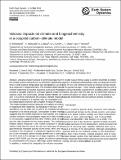Volcano impacts on climate and biogeochemistry in a coupled carbon–climate model
Author(s)
Rothenberg, Daniel Alexander; Mahowald, N. M.; Lindsay, K.; Doney, Scott C.; Moore, J. K.; Thornton, P.; ... Show more Show less
DownloadRothenberg-2012-Volcano impacts on c.pdf (6.775Mb)
PUBLISHER_CC
Publisher with Creative Commons License
Creative Commons Attribution
Terms of use
Metadata
Show full item recordAbstract
Volcanic eruptions induce a dynamical response in the climate system characterized by short-term global reductions in both surface temperature and precipitation, as well as a response in biogeochemistry. The available observations of these responses to volcanic eruptions, such as to Pinatubo, provide a valuable method to compare against model simulations. Here, the Community Climate System Model Version 3 (CCSM3) reproduces the physical climate response to volcanic eruptions in a realistic way, as compared to direct observations from the 1991 eruption of Mount Pinatubo. The model's biogeochemical response to eruptions is smaller in magnitude than observed, but because of the lack of observations, it is not clear why or where the modeled carbon response is not strong enough. Comparison to other models suggests that this model response is much weaker over tropical land; however, the precipitation response in other models is not accurate, suggesting that other models could be getting the right response for the wrong reason. The underestimated carbon response in the model compared to observations could also be due to the ash and lava input of biogeochemically important species to the ocean, which are not included in the simulation. A statistically significant reduction in the simulated carbon dioxide growth rate is seen at the 90% level in the average of 12 large eruptions over the period 1870–2000, and the net uptake of carbon is primarily concentrated in the tropics, with large spatial variability. In addition, a method for computing the volcanic response in model output without using a control ensemble is tested against a traditional methodology using two separate ensembles of runs; the method is found to produce similar results in the global average. These results suggest that not only is simulating volcanoes a good test of coupled carbon–climate models, but also that this test can be performed without a control simulation in cases where it is not practical to run separate ensembles with and without volcanic eruptions.
Date issued
2012-10Department
Massachusetts Institute of Technology. Department of Earth, Atmospheric, and Planetary SciencesJournal
Earth System Dynamics
Publisher
Copernicus GmbH
Citation
Rothenberg, D. et al. “Volcano Impacts on Climate and Biogeochemistry in a Coupled Carbon–climate Model.” Earth System Dynamics 3.2 (2012): 121–136.
Version: Final published version
ISSN
2190-4987